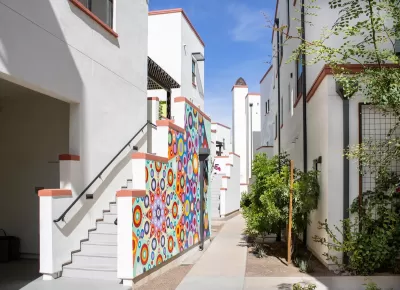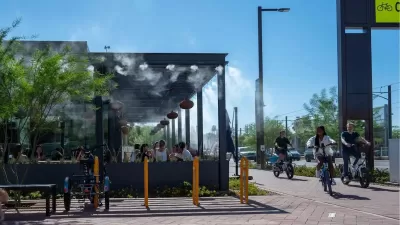Despite initial skepticism about its true potential for sustainable urbanism, the built-from-scratch “car-free neighborhood” is widely popular with its residents.

Culdesac Tempe, which billed itself as the nation’s first ground-up car-free neighborhood, seems to be a success for its residents, writes Ben Ikenson in Dwell.
With the first phase finished last year, the high-profile development continues to unfold on a 17-acre site along a light rail line in an established neighborhood about 15 miles east of downtown Phoenix. The $200 million project now includes 288 apartment units with about 300 tenants, reeling residents in with appeals of a healthier, more eco-friendly lifestyle, built-in community with ample amenities, and accessible transit to Tempe and the greater metro area.
According to Ikenson, the neighborhood received criticism for being relatively isolated and, according to Strong Towns, not “the incremental urbanism and thickening our cities need.” (Later, Strong Towns revised its opinion, noting “We all have a hand in building strong towns, and it can take many different forms. We’re here to celebrate every effort.”)
Residents seem satisfied with the neighborhood’s walkability, amenities, and transit access. The community offers free e-bikes and transit passes — and residents actually use them. Residents also say rents are reasonable, with studios starting at $1,300 per month in a region where median rent for a studio is $1,375.
Kevin DeGood, director of infrastructure policy at the Center for American Progress, acknowledged the community’s success, noting, “We need more housing and land use experimentation, not less. And bold experiments like Culdesac show there is real demand for alternatives.”
FULL STORY: America’s “First Car-Free Neighborhood” Is Going Pretty Good, Actually?

Study: Maui’s Plan to Convert Vacation Rentals to Long-Term Housing Could Cause Nearly $1 Billion Economic Loss
The plan would reduce visitor accommodation by 25,% resulting in 1,900 jobs lost.

North Texas Transit Leaders Tout Benefits of TOD for Growing Region
At a summit focused on transit-oriented development, policymakers discussed how North Texas’ expanded light rail system can serve as a tool for economic growth.

Why Should We Subsidize Public Transportation?
Many public transit agencies face financial stress due to rising costs, declining fare revenue, and declining subsidies. Transit advocates must provide a strong business case for increasing public transit funding.

How to Make US Trains Faster
Changes to boarding platforms and a switch to electric trains could improve U.S. passenger rail service without the added cost of high-speed rail.

Columbia’s Revitalized ‘Loop’ Is a Hub for Local Entrepreneurs
A focus on small businesses is helping a commercial corridor in Columbia, Missouri thrive.

Invasive Insect Threatens Minnesota’s Ash Forests
The Emerald Ash Borer is a rapidly spreading invasive pest threatening Minnesota’s ash trees, and homeowners are encouraged to plant diverse replacement species, avoid moving ash firewood, and monitor for signs of infestation.
Urban Design for Planners 1: Software Tools
This six-course series explores essential urban design concepts using open source software and equips planners with the tools they need to participate fully in the urban design process.
Planning for Universal Design
Learn the tools for implementing Universal Design in planning regulations.
City of Santa Clarita
Ascent Environmental
Institute for Housing and Urban Development Studies (IHS)
City of Grandview
Harvard GSD Executive Education
Toledo-Lucas County Plan Commissions
Salt Lake City
NYU Wagner Graduate School of Public Service





























